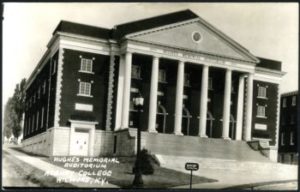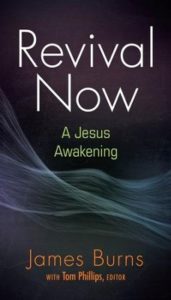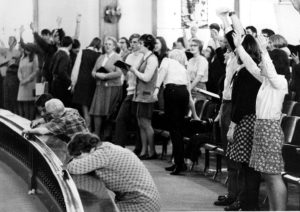CW and I entered a packed Hughes Auditorium at Asbury University. We had driven down to Wilmore, Kentucky, that morning of February 3, 2020, to attend the Special Extended Chapel, one of many events scheduled over two days to celebrate the 50th anniversary of the 1970 Asbury Revival. CW was a student at Asbury 50 years ago and experienced the revival firsthand. I was looking forward to experiencing it through the memorable stories I would hear that day.

On the arm of each seat was a small paperback book, a take-home gift: Revival Now: A Jesus Awakening. I have read it twice, and I’m not ready to file it away yet. The 4 x 7 inch book has only 96 pages, but it is a rich condensation of a much more in-depth writing published in 1909 by James Burns: Revivals, Their Laws and Leaders. In 2018, Tom Phillips edited the book we received. In it he republished portions of the original book because he felt the sections on the laws of revivals are pertinent today.
The condition of our country has had me thinking about the need for spiritual revival for quite a few years. We are drifting further and further from our spiritual beginnings, resulting in increased unrest, division, hatred, and lawlessness. A basic definition of revival is “renewed attention to or interest in something” (Merriam-Webster). I believe renewed interest in and attention to God is the answer to our woes. Since God created everything, He is the One Who knows how to fix our messes. So I had a serious interest in what James Burns had to say about revivals.

There is so much in this little book that I’ll just share some things that had the most impact on me. First of all, I was fascinated to read that revivals are governed by laws. The first is “The Law of Progress.” (I won’t go through all 11 laws.) Burns uses the illustration of an incoming tide. Each wave is revival. It marks its spot on shore, then it recedes. But as it falls back, it is gaining strength for the next wave to rush further in. This was my first aha moment.
I wasn’t aware of much permanent outcome from the human-planned revivals I’ve known. I sadly had the idea that after a revival ended, most of what was gained eventually slipped away and was forgotten. So it is most encouraging to discover that each revival builds upon past revivals, each one carrying humanity to further progress.
The 1970 Asbury Revival is an example to me that when God authors a revival, the progress does not fade away. It was evident in the testimonies shared at the 50th anniversary that the participants were profoundly affected. The work the Holy Spirit did in those people reached far beyond their campus and is still having an impact in their spheres of influence today.
In “The Law of Variety,” we see how each revival has unique characteristics, designed by God according to what He knows is needed at the time. One example is whether it appeals more to the emotions or if it is mainly theological. Sometimes we need emotion, but Burns cautions that we need to guard against getting swept up in emotion to the extent we don’t experience change.
Another example of variety is that the direction of a revival will be opposite that of the previous one. He used politics to illustrate this. Like in politics, religion has two distinct groups of people: liberals with the watchword of Freedom and conservatives with the watchword of Authority. They are in constant conflict with each other, but both are extremely important. Revivals keep us from going too far in one direction. When the words freedom and authority are used, it helps my understanding and perception of both groups. Jesus is our Authority and He died for our Freedom. We can’t live without either one.

Even though all revivals are different—such as location, duration, leadership, appeal, direction—each one has the same message at its heart: the Cross. Burns says that whenever the Church has become powerless, it is because we have either denied or forgotten the Cross. The purpose of revival is to point the way back to Christ, to the source of life. This is the simplicity of “The Law of the Theology of Revivals.”
In the last chapter, “The Law of the Coming Movement,” the author first examines the state of the Church. In general, it has become impotent. Materialism has crept into the Church, and the world sees the contradiction between the teachings of Jesus and the attitude of the Church toward the world. Also, there is theological unrest causing the validity of the Bible to be questioned. Many preachers tend to teach about living good lives but stay away from disputed doctrines. Because the Church has weakened so much, we question her future. But the author assures us that,
“The Church is not on the eve of destruction. It is on the eve of revival. Like the day that comes when the long night is over, so every revival comes after times of tribulation . . . The question is not if, but when.”
And the when is always in the hands of God. We pray for revival, and that is important, but according to Burns, our prayers do not cause a revival; they are our preparation for it. He says a few people, not the Church as a whole, become aware of the need and begin to pray. It grows into a heavy burden and God hears their cry. But if devout people everywhere are not “becoming alarmed . . . for the glory of Christ,” the darkness is not deep enough yet. A revival would not be effective if we’re not prepared for it.

At Asbury, there was a student who had a burden for her college. She managed to get every student’s name from the registrar. She carried them in a thick binder around campus and prayed for each student individually. She and others met regularly to pray expectantly for spiritual renewal on campus. On the morning of February 3, 1970, the dean of the college was scheduled to speak in chapel. Instead, the Holy Spirit led him to invite people to share personal testimonies. God said it was time. A revival began that lasted 185 continual hours and cancelled classes the entire week.
This book was enlightening as to how God works through revivals to guide the Church and bring salvation to His people and good to the world. It was wonderful to read that God will not allow “one’s spiritual nature . . . to stagnate for long periods.” And whatever the next revival looks like, its message will “bring the Church back to the needs of the poor . . . [it] will move us toward unity . . . [and] above all, it will bring us back to Christ.”
~~~
A bonus is found in the appendix. Phillips describes a spirit-empowered faith, which he says “is relational and impossible to realize apart from a special work of the Spirit.” He uses scripture to identify 40 outcomes of this kind of faith and organizes them into four categories: loving the Lord, loving the Word, loving people, and loving His mission. Following each of the eleven chapters are experiential exercises. Each set focuses on one of the ten outcomes of Loving the Word. All 40 outcomes can also be found at the Great Commandment Network, though you do have to give your email address to download the free documents.
Other books on revival by Tom Phillips can be found at The Center for Awakening, along with a “Sparks of Revival” blog.
Revivals, Their Laws and Leaders by James Burns is out of print, but in my online search, I found a facsimile reprint of the original published as recently as 2010 by Kessinger’s Rare Reprints.
Feature photo by Edwin Andrade on Unsplash




Brenda Murphy
January 27, 2021This is certainly a time to cry out for our nation. God’s arm is not too short to save. My cry has been, “Show your power.” I also find I have a deep burden for the confused in our nation. But hey, Bride, this is our time to shine!
bspencer
January 27, 2021Good words, Brenda. And yes, God’s light will shine brightly through us in such dark times as we seek to bring glory to Him.
Angie Camp
January 28, 2021HE is our authority and HE died for our freedom. Well said.
The Asbury student shows the privilege, the responsibility, and the power of prayer. I am motivated to pray more faithfully.
SO glad you and CW attended the university…that visit probably drew you closer together, Angie
bspencer
January 28, 2021Privilege, responsibility, and power. I like that. It truly is a privilege to be able to speak directly with God and talk to Him about what He wants to do in our lives and in our world. Thank you, Angie.
Becky Hancock
February 9, 2021Bonnie, I read this one while in Florida and never got back to responding but this one really spoke to me. I especially was challenged by the thought that God would not allow us to remain stagnant spiritually. I have friends (Betsy and Lincoln Stevens) who went to the anniversary event at Asbury and a cousin who was a student there during the revival (Angie MacKay – in case CW would know them). The Asbury students came to visit our college in Mt. Vernon, OH and share their stories that year. I long to see a movement of the Holy Spirit like that in our day! I want my kids and grands to witness that miracle. I remember many revivals as a child and teen when we would stay for long hours around the altar and have the sweet anointing of God and testimonies, one after another. Thanks for sharing these thoughts, Bonnie, and pointing us to the hope that God can do this again!
bspencer
February 10, 2021CW remembers Lincoln as a student leader in his class. CW also went out from the revival to share his testimony. He went to the church in Ohio where his father was pastoring. I loved hearing all the stories of how God moved in their lives.
I, too, long for a new movement of the Holy Spirit in our nation. God is the only hope for our dark times. I feel as though God is doing so many things to awaken His people, me included, so that prayerful preparation can be made for what He intends to do.